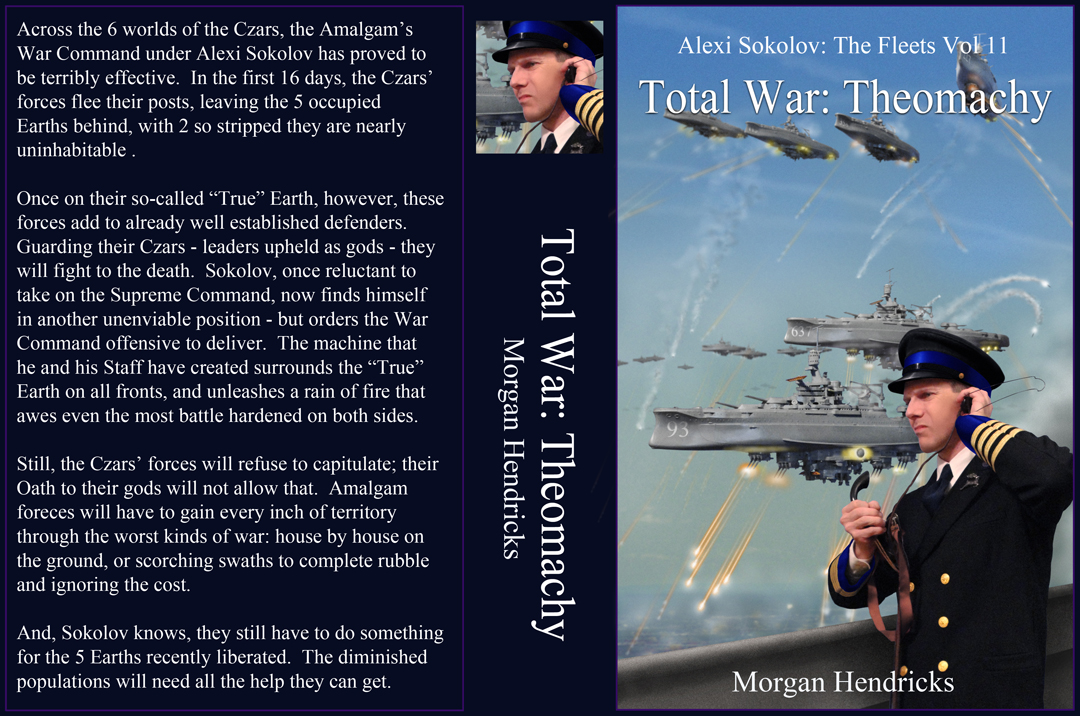




Alexi Sokolov: The Ether Fleets - the Total War series
When we last saw Admiral Sokolov, he and the Ether Fleets Staff had discovered that the nascent Amalgam was not the only conglomeration of parallel Earths. Unlike Sokolov's worlds, this group of Earths exists in a very different milieu, a way of life that is in direct opposition to the attempt at peaceful integration that underpins the Amalgam Charter. Total War chronicles the events of the Amalgam Fleets in action against the Czarist's True Earth.
Page Three Page Four back to Page Two Page One
Sokolov's introduction in the Vera Packard Series of book covers.
For more on the dreadnoughts there are these: Pennsylvania Class: Trial Run Pennsylvania Class: The Inspiration
I guess you could say that Sokolov was introduced in the Vera Packard series, as he wasn't a "cross-over" character at the time since he didn't have his own series. This, then, would be the Sokolov "origin story," which ran on rather longer (in the number of covers and the amount of time devoted to crafting them) than I thought it would. While I can imagine going further, either with Sokolov alone or in conjunction with Vera Packard, the Ether Fleets will take a back burner for some time yet.
Finishing, or at least rounding-out, this series has been somewhere between "front" and "back" burner for quite a long time now, as I mentally bounced around ideas for the imagery. After creating The Fleet-In-Being (back when-ever that was) I had a sudden rush of ideas of how the story would progress, and had gone so far as to create the covers with complete back-blurbs; to do the cover art any kind of justice, however, I knew I needed photographs that showed a landscape from more than a few stories off the ground. Fleet-In-Being and Endgame in the Packard series utilized photos taken from Mt Washington, which affords a pretty high angle over Pittsburgh and the Monongahela and Ohio Rivers, but that vantage was not really high enough nor far enough away to give the impression of a fleet of floating battlewagons hovering at offensive altitude. The view from the Observation Deck of the One World Trade Tower in Lower Manhattan, though, did prove to be suitable, so the distant landscapes in the images above are of New Jersey and New York as seen from a thousand feet above the New York. It was much cheaper than hiring a helicopter! (More of those observation deck images can be viewed toward the bottom of this After Dreiser page.)
The other problem was that regardless of the background, the number of Dreadnoughts I would need to include to convey the number of ships at Sokolov's disposal would be fairly large, and frankly I was a little daunted at the prospect of shooting them with slightly different camera angles and with the right lighting and then isolating them in Photoshop - and - and - and - and I just "hemmed and hawed" until more time had gone by. Then I said "well that's dumb" and resolved to just do the work.
Other notes: the background for volume eight is the officers' mess on board the USS Growler, the 1950s era guided missile submarine docked as part of the Intreped Air Sea and Space museum in New York City.
For volume nine, I will admit that I was unsure just how to portray a building blown up by a bombing, much less how to portray Sokolov in relation to it. That I was both inspired and put-off by the imagery following the destruction of the World Trade Center was part of this, sure, but so the story had progressed, and eventually I realized that instead of yet-another "on high" view I could stay at ground level. This view was made possible because a bank in downtown Lafayette was being torn down affording the prospect of taking photos of chunked-up walls and piled-up building materials. The afternoon I went 'round to take pictures turned out to be ideal - not only because of the light (it wasn't raining that day) but also because it was the only time that the remains of the structure were piled up "just so;" another day later and most of the detritus had been removed. At the time of this writing, it is a dirt lot.
As to the title of volume eleven: theomachy is, according to the Concise Oxford English Dictionary: "a war or struggle against God or among the gods...from Greek theomakhia, from theos 'god' + -makhia 'fighting'." I have no recollection of how I came across this word, but having stumbled across it I thought "That's perfect!" and it went on to the book.
Below: Bank-No-More.

